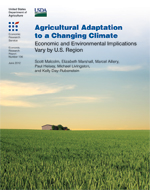Agricultural Adaptation to a Changing Climate: Economic and Environmental Implications Vary by U.S. Region
- by Scott Malcolm, Elizabeth Marshall, Marcel Aillery, Paul Heisey, Michael Livingston and Kelly Day Rubenstein
- 7/6/2012
Overview
Global climate models predict increases over time in average temperature worldwide, with significant impacts on local patterns of temperature and precipitation. The extent to which such changes present a risk to food supplies, farmer livelihoods, and rural communities depends in part on the direction, magnitude, and rate of such changes, but equally importantly on the ability of the agricultural sector to adapt to changing patterns of yield and productivity, production cost, and resource availability. Study findings suggest that, while impacts are highly sensitive to uncertain climate projections, farmers have considerable flexibility to adapt to changes in local weather, resource conditions, and price signals by adjusting crops, rotations, and production practices. Such adaptation, using existing crop production technologies, can partially mitigate the impacts of climate change on national agricultural markets. Adaptive redistribution of production, however, may have significant implications for both regional land use and environmental quality.
Download
-
Entire report
Download PDF -
Report summary
Download PDF


